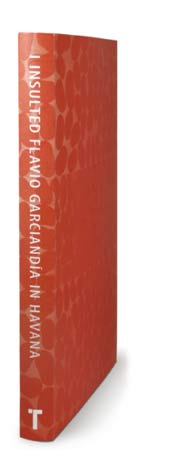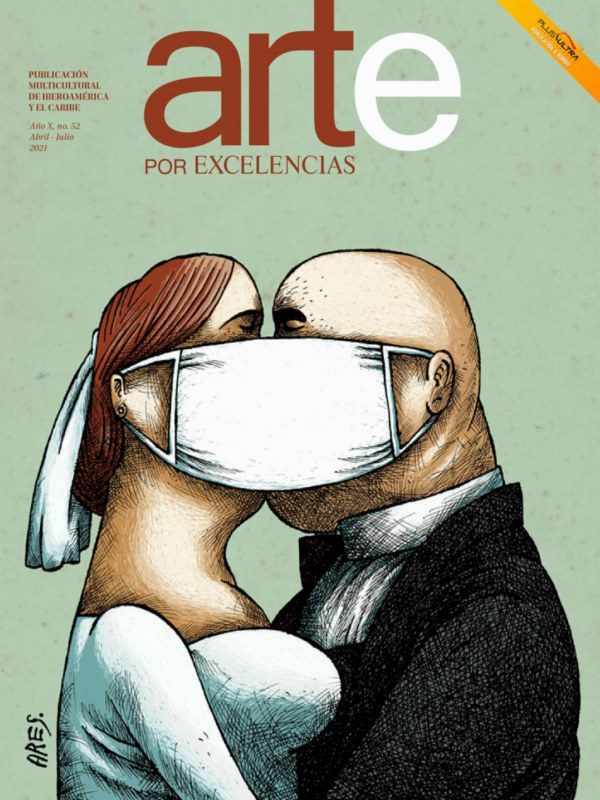 Regardless of its bulkiness, this is not an opera summa book on Cuban painter Flavio Garciandia, who given the precociousness of his early-bird creation and the vastness of his work, can be allegedly seen as an artists who has already reached the pinnacle from where life is looked back… And though it seems so because of its summarizing touch, the book is not intended to be an anthology, no less the substitute to a “reasoned catalog.” It is no doubt a timely recap of what the artist has done –still in the peak of his skills and characterized by nonstop inventiveness in terms of artistic creation–, a second, more exhaustive visitation to his career. But it is above all an open book with an active projection since it showcases a work which is still underway.
Regardless of its bulkiness, this is not an opera summa book on Cuban painter Flavio Garciandia, who given the precociousness of his early-bird creation and the vastness of his work, can be allegedly seen as an artists who has already reached the pinnacle from where life is looked back… And though it seems so because of its summarizing touch, the book is not intended to be an anthology, no less the substitute to a “reasoned catalog.” It is no doubt a timely recap of what the artist has done –still in the peak of his skills and characterized by nonstop inventiveness in terms of artistic creation–, a second, more exhaustive visitation to his career. But it is above all an open book with an active projection since it showcases a work which is still underway.
The chronological layout of this inventory is from back to front. That is, it takes a peek at the whole from the most recent stage of his artistic career –the year 2008, according to the date of the “Yo insulté a Brice Marden en La Habana, dos veces” reproduction, plus two other canvases dated in 1997 and 1988 that were retaken in 2008– all the way to the onset period when he made his first drawings in the 1970s. That retrospective order hinges on the painter’s vitalistic stance, positioned in the here and now of his professional development, and it calls for an analytical pause in order to move on toward the next expressive proposal. In the last chapter but one of the book, the Chronology –penned by Jose Veigas– takes back on the regular sequence of Garciandia’s work and life.
The volume counts on an ample compilation of critical writings and interviews likened to the painter’s different thematic-stylistic periods: the forewords are “brief, praising and thoughtful” by the hand of editor Cristina Vives; The Flavio Revelation by Kiki Alvarez; the comments by Juan Antonio Molina on the reconstruction of post modernity; about his “borrowings, recreations and inventions,” by Edward J. Sullivan; the “visits” by Lupe Alvarez and Osvaldo Sanchez to the “Museum of Tropical Art”; the text by Gerardo Mosquera that runs through his essays of post-hyperrealistic figurative distortion; and the conversation between Catherine Lampert and Garciandia as “a man split in two parts: one half linked to analytical and conceptual matters –as the interviewee himself puts it– and the second half focused on painting’s tearing and pleasure.” Those texts plus the brief notes and opinions culled in this chronology clearly illustrates Flavio Garciandia’s diverse and complex pictorial trail.
In an effort to spell out all by himself the evolution seen in this pictorial trail, let’s backpedal the established retrospective layout to its natural temporality: Flavio’s work has swayed from a realistic figuration to a subjective one and from there to a piecemeal conversion of the formal elements all the way to absolute abstraction. In the takeoff –considering as such a level of execution that moves far beyond scholastic mimesis– we find drawings made in ink or crayon on both paper and cardboard between 1969 and 1972 –desolate landscapes of rugged foliage, rows of little houses next to a space whose emptiness plays an extraordinary compositional function– as well as the polyptych of half a dozen variants from the same scene drawn in ink and casein on the base of a lithographic image, an image that appears to be a resounding of Francis Bacon’s morbid composition. This one in particular is both the binding energy and the thematic profile of Flavio’s posterior work: his liking for art history –with emphasis on post-avant-gardism iconography– his unlimited curiosity for information sources that lead him to knowing his painting with intelligence in both content and form, yet stripped of the cult for humorous accents and well-defined lampooning sense ingrained in it. This marks the statement and style that stamp his character, something that is immediately confirmed in his 1974-1975 artwork entitled “Marcel Duchamp está vivo”, the first clear-cut token of his identification with artistic culture. Later on, he embarked on a remake of Picasso’s Guernica entitled “The Desire” (the desire to be legitimized by such a monumental piece of work) painted in 1982 on the heels of his formidable cycle “Notes for the Study of the Conquest”, the El Dorado / The Emigrants series in 1980, and before that the hyper realistic portraits of Antonia Eiriz –“Nothing Personal”, 1977– and from Zaida del Rio the work entitled “All You Need Is Love”, 1975– which were all the rage.
The opposite side of that special love for the contemporary arts, cosmopolitism and his paradigms storms into an open and receptive sensitivity like Flavio’s, thus becoming evident and present: his proposal beginning in 1982 with the “Catalog of Bad Shapes” series and the Tropical Path individual exhibition; the Sayings series in 1984; the printing designs for textile fabrics in Telarte (1983-1986), Palettes, Sculptures and Some Paintings (personal, 1989), the “Marco Polo Syndrome” (1986) and Marco Polo’s Second Voyage (1991) installation; and the individual exhibitions entitled A Visit to the Museum of Tropical Art (1994) and Tropical Abstraction (1997). These works eventually introduced a revolving and iconographic vision whereby the painter zeroes in on that discriminated-against area of popular esthetics, the autochthonous expressions not labeled as folkloric, of unnoticed courses on liking –the primary, the chic, the kitsch– that spill over its boundaries and invade incompatible spaces: the artist doesn’t intend to legitimize such incongruence and he sees in it the expression of a reality in its original status. Flavio takes mass media elements into his own ambience, idiosyncratic and ideological elements inserted in the national culture. He puts the potentiality of the local before the hegemony of centrism in the realm of the art.
Since then, hasn’t he satirized models out of that centrism and even lampooned himself? There are no signs of bowing recognition toward the sacred cows: the titles of his works now underscore a jaunty and irreverent arrangement whereby Flavio dissembles the hieratism of that bluffing side of the Art institution: “Who’s Afraid of Barnett Newman”, “Clyffod Still Picking Up Mangos in My Backyard (Flavio Garciandia was there)”, “I insulted Clement Greenberg in La Habana”, “I insulted John Baldessari in… Havana”, “The Strange Sexual Life of Matthew Barney”, “Dylan Is God (No Overdoing Please”, “Julian Schnabel and Sean Penn Measure and Compare their Penises (Shit! said Schnabel, “Ives Klein Jumps Himself into the Pit at the Havana Malecon (Restany Jumped Later and Hit Himself Hard”, “Rothko in Underwear (A Pictorial Suicide)”, “Riley Sprinkled”, “Poco Picabia”, “Poco Motherwell”, and the long list of dubious apology goes on and on into the 2000 decade. The sarcasm stretches out to other topics without proper names and thus denotes the author’s wisdom to work out the uncomfortable challenge of baptizing the concluded artwork.
Closing the book –better yet, opening the book– the Auge collective project or the decadence of the Cuban art –invited to participate are fifty eight Cuban fine artists, a collateral action within the framework of the 9th Havana Biennial– that Flavio augments with the purpose of “inducing and/or inciting some kind of critical reflection on the issue.” As a matter of fact, the book is conceptually divided into inquiring and thoughtful reflection on the rights that help artists in their lifetimes, their artworks and before the art, removed from the catalog-tabloid designed for the 2000 exhibit entitled Had No Right to Color. One of them says: “The right of every artist not to be subjected to unjust interferences in his work, his career, his market, or to attacks against his prestige or reputation (if any)…”
I insulted Flavio Garciandia in Havana, Edición Cristina Vives / Flavio Garciandia, Turner Editores, Madrid, 2009.
Related Publications

How Harumi Yamaguchi invented the modern woman in Japan
March 16, 2022












